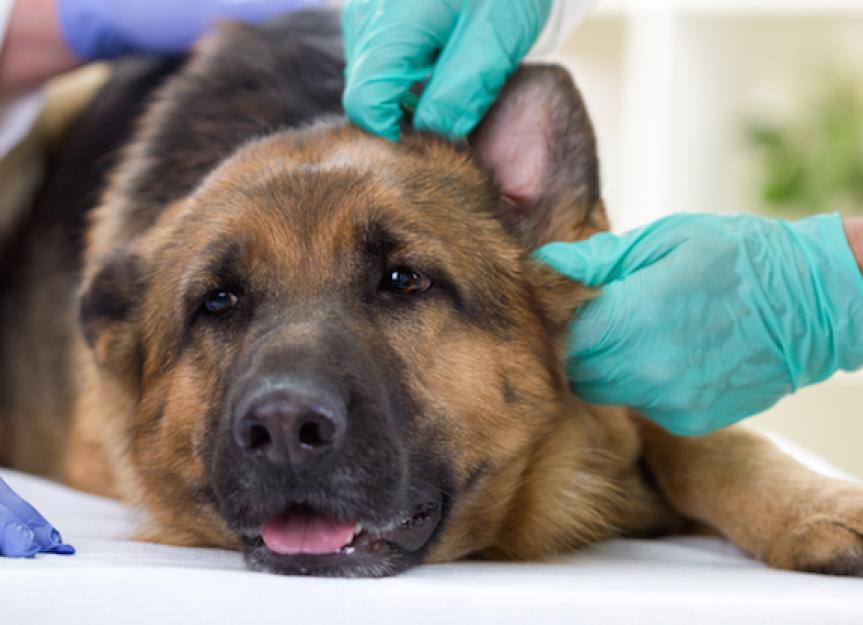Chronic Ear Infections and the TECA
Ever had a pet with chronic ear infections? Both dogs and cats can have these. And when they're severe enough, the best choice is usually to remove their ear canals entirely.
Sad as it sounds, this is how we handle things when they get out of control in this hard-to-reach area. While most owners rebel against this kind of dramatic surgical option (called a TECA, short for total ear canal ablation), it's always better than the chronic pus, pain, and everything else that comes with it.
By way of an excellent explanation, I've enlisted my veterinary surgeon boyfriend's help. Here's his description of the problem and the procedure. While it was intended for veterinarians to digest, I think you're all smart enough to get it too.
Chronic otitis is a common and frustrating disease for owners and veterinarians. For the patient, the case is much more critical –– they are often in severe pain. The pain and itch associated with chronic ear infections makes the owners’ frustration (and ours) seem petty in comparison.
While appropriate medical management is often successful in curing acute otitis, all too often it only diminishes the signs temporarily, or fails altogether. Owner compliance can be a problem, and many cases go undermedicated.
在许多情况下,有一个潜在的cause which leads to failure of medical management. In these cases, resolution of the cycle of pain, itching, headshaking, chronic medication, and owner complaints can be provided with surgical ablation of the ear canal. This technique is also useful in the treatment of other ear diseases, like neoplasia (cancer) and traumatic ear canal injuries.
Otitis can beexterna(of the ear canal alone),media(involving the middle ear) or interna (involving the skull bone and its constituents: the hearing center –– cochlear apparatus –– and balance center –– vestibular apparatus and the brain).
While we usually focus on the bacterial and fungal components of the disease, most cases of chronic otitis cannot be resolved if an underlying cause is not identified and eliminated.
The underlying cause is often allergic, with environmental allergies and food allergies most common. These patients get stuck in a cycle of inflammation, infection, and fibrosis which eventually leads to collapse of the ear canals, a ruptured ear drum, and debris and infection within the middle ear.
Over time, the ear canals ossify, and scar tissue occludes the canals, preventing topical medications from reaching the diseased portions. The occluded canals also prevent the natural sloughing of ear canal skin cells, sebum (wax) and hair, which accumulates in the canals, and within the middle ear.
Many surgical techniques have been described for the treatment of chronic otitis. Of these, most have been focused on opening up the ear canal. This approach was based on the notion that the ear canal needs air to dry, or to facilitate the instillation of medications.
Techniques like the lateral wall resection (Zepp procedure) and vertical canal ablation have been advocated in the past, but are only applicable for focal (discretely located) disease of the vertical ear canal. Most cases of chronic otitis involve the entire ear canal, extending through a ruptured ear drum and into the middle ear. For these more typical cases, these surgical techniques are contraindicated.
Only a Total Ear Canal Ablation (TECA) with a lateral bulla osteotomy (LBO) addresses the entire disease process.
The TECA is a procedure that removes the vertical and horizontal ear canals down to the level of the middle ear. Due to the high incidence of middle ear involvement with chronic otitis, the middle ear is debrided (cleaned) via a lateral bulla osteotomy.
Usually a large amount of debris, hair, and pus are found in the bulla. It comes as no surprise, then, that these cases of chronic disease do not resolve medically given the amount of debris within the middle ear. The most common complications with the TECA are recurrent abscessation, facial nerve paralysis, and vertigo. The incidence of abscessation is less than ten percent. Facial nerve paralysis and vertigo are usually temporary, and resolve without specific treatment.
Many owners are concerned about deafness after the surgery. While the TECA removes the apparatus that transmits sound via the air (i.e., the ear canal and ear drum) sound can still be sensed via the vibrations that come to the cochlear apparatus through the sinuses and skull. This is similar to the level of hearing one experiences when wearing earplugs. No sound reaches the cochlear apparatus through the air, but we can still hear sounds and voices.
现实情况是,大多数狗with chronic otitis are already hearing at this low level due to the collapse and obstruction of their ear canal and middle ear, where no sound waves are being transmitted via the air. Most owners do not report a change in their pets’ ability to hear after a TECA.
Fundamentally, the TECA is a very rewarding surgery for the patient, owner, and veterinarian. Most owners report a dramatic improvement in the attitude of their pets postoperatively, claiming they see a return of social and play behaviors they have not seen in many years.
This, combined with releasing them from the drudgery of daily ear cleaning and medication administration, offers the owner a huge sense of relief. As we have gained more experience with the TECA procedure, there has been a movement to recommend it earlier during the course of the disease.
No longer is the TECA viewed as strictly a salvage procedure of last resort. Many dogs and cats with chronic otitis are candidates for the surgery once it becomes clear that they are in that all-too-familiar cycle of otitis that many of us find the bane of our daily lives.
Image:VP Photo Studio/ Shutterstock
Help us make PetMD better
Was this article helpful?
